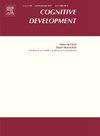执行功能中的监控与元认知监控有关吗?
IF 1.8
3区 心理学
Q3 PSYCHOLOGY, DEVELOPMENTAL
引用次数: 0
摘要
迄今为止,执行功能(EF)和元认知(MC)一直被分开研究,但在理论层面上,它们却有共同之处。目前还不清楚这些技能在幼儿身上是否存在关联,更重要的是,它们之间的监测过程是否存在关联。在此,我们用 "心花怒放 "任务测试了 6 至 8 岁儿童(312 人)的 EF,用配对联想记忆任务测试了 MC,并将重点放在作为潜在关联过程的监控上。我们考察了儿童在 "心花怒放 "任务中的准确率和反应时间(RT),以及作为监控指标的错误后减速。我们测量了儿童在配对联想任务中对答案的准确性和信心判断的延迟,分别作为显性和隐性元认知监控的指标。结果表明,对于EF中的抑制和转移成分,儿童在 "心花怒放 "中的反应时间与记忆监测判断的潜伏期之间存在显著的正相关。也就是说,自我评估记忆表现(即元认知监控)较快的儿童,其执行功能也较快。关于 "心与花 "任务的准确性与记忆监控之间的关系,尚无定论。出错后的速度减慢与任何记忆监控措施都没有关系。总之,这些研究结果表明,在 6 至 8 岁的儿童中,执行功能与记忆监控之间的关系很弱,尽管两者都可被视为高阶认知过程。虽然儿童在EF和MC中都表现出监测的迹象,但监测不太可能解释两者之间的联系。本文章由计算机程序翻译,如有差异,请以英文原文为准。
Is monitoring in executive functions related to metacognitive monitoring?
Executive functions (EF) and metacognition (MC) have so far been investigated separately, yet, on the theoretical level, they share commonalities. It remains unclear whether these skills correlate in young children, and more importantly, whether monitoring processes within each may be associated. Here, we tested 6- to 8-year-old children's (N = 312) EF with the Hearts and Flowers task and MC with a paired associates memory task and focused on monitoring as a potential associated process. We examined children's accuracy and reaction time (RT) in the Hearts and Flowers task, as well as their post-error slowing as an indicator of monitoring. We measured children's accuracy and the latency of their confidence judgments for their answers in the paired associates task as an indicator of explicit and implicit metacognitive monitoring, respectively. Results showed that, for both inhibition and shifting components of EF, there was a significant positive correlation between children's RT in the Hearts and Flowers and the latency of memory monitoring judgments. That is, children who were faster in self-evaluations of their memory performance (i.e., metacognitive monitoring) were also faster in executive functioning. Evidence for the relationship between accuracy in the Hearts and Flowers task and memory monitoring was inconclusive. Post-error slowing was not associated with any measure of memory monitoring. Together, these findings suggest that EF and memory monitoring are rather weakly associated in 6- to 8-year-old children although both can be considered as higher-order cognitive processes. Although children show indications of monitoring within both EF and MC, monitoring is unlikely to explain their link.
求助全文
通过发布文献求助,成功后即可免费获取论文全文。
去求助
来源期刊

Cognitive Development
Multiple-
CiteScore
3.20
自引率
5.60%
发文量
114
期刊介绍:
Cognitive Development contains the very best empirical and theoretical work on the development of perception, memory, language, concepts, thinking, problem solving, metacognition, and social cognition. Criteria for acceptance of articles will be: significance of the work to issues of current interest, substance of the argument, and clarity of expression. For purposes of publication in Cognitive Development, moral and social development will be considered part of cognitive development when they are related to the development of knowledge or thought processes.
 求助内容:
求助内容: 应助结果提醒方式:
应助结果提醒方式:


